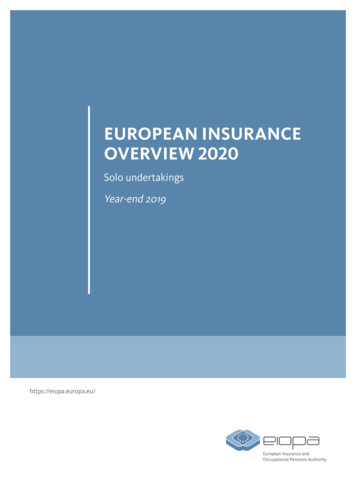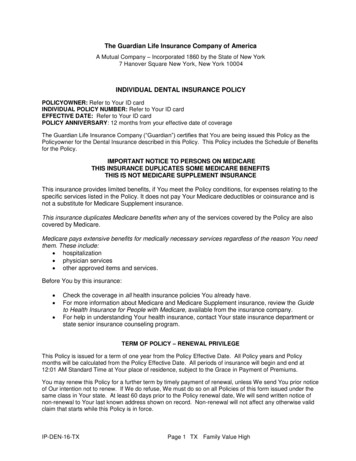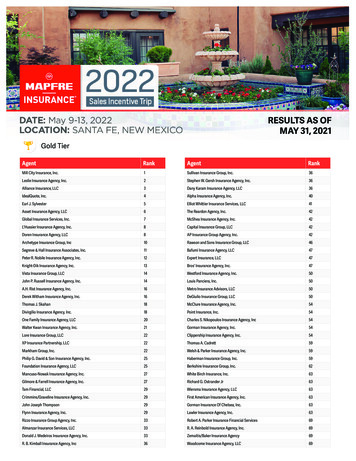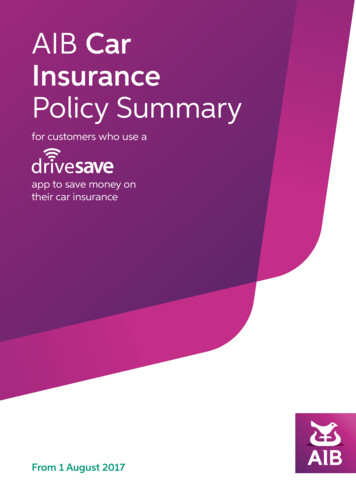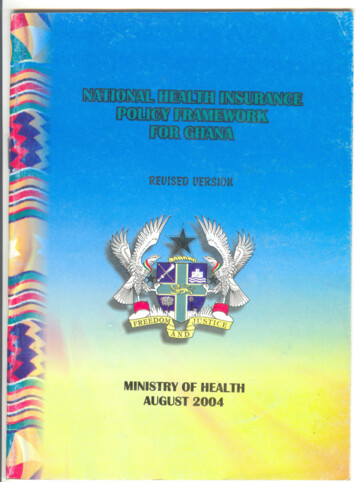
Transcription
MINISTRY OF HEALTHAUGUST 2004L --JJ
National Health !t1§urancePolicyTABLE OF ive SummaryIntroductionContext of Health InsuranceIVThe Vision, Goal and ObjectiveThe VisionThe GoalThe Policy ObjectivePrinciples underlying the DesignTypes of Health Insurance SchemesDistrict Mutual Health Insurance SchemePrivate Mutual Health Insurance Sch mePrivate Commercial Health Insurance SchemeStructure of District Mutual health Insurance SchemeTowards Achieving Universal Equitable CoverageMinimum ContributionBenefit package. HealthFacilitiesproviding Health Services under the NHISAccessing services under the NHISAccreditation and Quality CareFunding the District Mutual Health Insurance SchemeRegulating the Health Insurance SchemesPolicy, Planning, Monitoring and Evaluation UnitLicencing and Accreditation UnitAdministration, Management Support and Training UnitFund Management and Investment 919202020
iiNational Health Insurance PolicyFinance and Service Delivery SystemInformal sector CategorisationThe Gatekeeper SystemFund FlowSummary of Framework for NHISMinimum Healthcare Benefit.FIGURES12345APPENDIXI
iiiNational Health Insurance PolicyFOREWORDThis review has been inspired by the changes that occurred in thedevelopment process of Health Insurance after the passage of Act 650 inOctober 2003. Further work has been done in respect of the legislativeinstrument; a more detailed benefit package for health care providers havealso been developed; and provider accreditation system has been completed.The result of all these new developments, challenge the original philosophiesand some of the concepts underpinning the earlier version of this policydocument.This new edition therefore brings to focus the concept of the fusion of theSocial Health Insurance Scheme and Mutual Health Organisation; it alsoadvocates for the concept of cross-subsidization, equity, solidarity and reengineering of the health insurance system in favour of the poor and underprivileged in society. In this regard, the new policy advocates the stratificationof society based on ability to pay contributions. The document also describesthe benefit package and issues of accreditation of providers.Despite all these changes, the old edition still has some relevance and hasserved as a platform for advocacy of the concept of Health Insurance toGhanaians. This was developed with immense contribution of a NationalHealth Insurance team set up in early 2001 made up ofthe following: Dr. S.A.Akor, Mr. Ampong Darkwa, Dr. Ian Kluvitse, Mr. Joseph Kofi Adusei, Dr.Irene Agyepong, Dr. 1. T. Teprey, Mr. Kwesi Eghan, Nii AyikofiArmah andMr. Osei Owusu.I will like to also thank all stakeholders who participated in the discussionsduring the drafting of the 2002 policy framework. It is by their collectiveefforts that has led to the writing of this new edition. Prominent amongstthem are the Civil Servants Associations, Ghana National Association ofTeachers, Ghana Medical Association, The Ghana Police Service, GhanaEmployers Association, Social Security and National Insurance Trust(SSNIT), The Trade Union Congress, Institute of Economic Affairs, Civil
National Health Insurance Policy.Society Organizationsivand many others.The doors ofthe Ministry of Health and the National Health Insurance Councilare still open for suggestions for consideration for future policy review. It is the'hope of Ministry of Health that Health Insurance becomes the main vehiclefor health care financing in Ghana.
v".National Health Insurance PolicyACKNOWLEDGEMENTThis is to acknowledge the contribution of the following persons for thereview of the policy document on the National Health Insurance Scheme; Dr.S. A. Akor (Director PPME, also Co-ordinator of the National HealthInsurance Scheme), Mr. KofiAdusei (Ministry of Health), Nana KwasiAmo(Managing Director, Organisation and Systems Limited) and Mr. F. X.Andoh-Adjei (SpecialAssistant to the Minister of Health).r.lThis review was inspired by the changes occurring in the Health Insurancesector. A National Health Insurance Act has been promulgated, and thelegislative instrument is about to be completed. A design concept and a newbenefit package have also been widely discussed and approved. These newdevelopment questions the original philosophies and some of the conceptsunderpinning the old policy document and calls for a new one.
,.,.National Health Insurance PolicyPage 1EXECUTIVE SUMMARYIn line with the Ghana Poverty Reduction Strategy(GPRS)the governmenthasinitiated a policy to deliver accessible, affordable, and good quality healthcare to all Ghanaiansespeciallythe poor and most vulnerable in society.The current out-of-pocket payment for health care at the point of servicedelivery popularly known as "Cash and Carry" poses a financial barrier to Ihealthcare access. Indeedit is estimatedthat out of eighteenpercentof thepopulation who require health care at any given time, only twenty percent ofthem are able to access it. That is about eighty percent of people living inGhana who need health care cannot afford to pay out-of-pocket at the point ofservice use. This has resulted in delays in seeking health care, noncompliance to treatment, and consequently premature death.To address the problem of financial barrier to health care access, thegovernment in 2001 has initiated a National Health Insurance Scheme as ahumane approach to financing health care.The aim of the health insurance scheme in Ghana is to enable the governmentachieve its set health goal within the context of the GPRS and the HealthSector Five YearProgramme of Work,2002-2006.Ultimately, the vision of government in instituting a health insurance schemein the country is to assure equitable and universal access for all residents ofGhana to an acceptable quality package of essential health care. The policyobjective is "within the next five years, every resident of Ghana shall belongto a health insurance scheme that adequately covers him or her against theneed to pay out-of-pocket at the point of service use in order to obtain accessto a defined package of acceptable quality of health service.Ghana is committed to fashioning out its own unique health insurancestrategy based on the Principles of Equity, risk equalization, crosssubsidization, solidarity, quality care, efficiency in premium collection,community or subscriber ownership, partnership, reinsurance, andsustainability.I
J"Page 2National Health Insurance PolicyHence the two main types of health insurance regimes shall be operational inGhana. These are the Social-type Health Insurance Scheme made up ofDistrict Mutual Health Insurance Scheme and the. Private Mutual HealthInsurance Schemes and the Private Commercial Health Insurance Schemes.rtThe government has elected to support the development ofthe District MutualHealth Insurance Scheme (DMHIS) to serve as a strategy for delivering itspro-poor policy to the underprivileged segments of the society. The DistrictMutual Health Insurance Scheme is therefore, a fusion of the two concepts;the traditional Social Health Insurance Scheme for the formal sector workersand the traditional Mutual Health Insurance organisations for the informalsector ofthe society. Thus, DMHISs will incorporate members from both theformal and informal sectors. All the types of insurance models shall havegoverning boards to bring about best management practices, good governanceand democracy.It is compulsory for every person living in Ghana to belong to a healthinsurance scheme type. This is in the light of the spirit of solidarity, socialresponsibili y, equity, and a sense of belongingness in the building of ahealthy and prosperous nation.Every person living in Ghana shall contribute according to the principle ofability to pay in order to enjoy a package of health services covering over 95%of diseases afflicting Ghanaians. There is a differential contribution levelboth in the formal and informal sectors ofthe society.The formal sector shall contribute 2.5% of their 17.5% Social Security andNational Insurance Trust (SSNIT) contribution whereas the informal sectorshall contribute at least 72,OOOper annum. The contribution levels have aninbuilt cross-subsidization mechanism whereby the rich pay more than theless privileged, adults pay on behalf of children, the healthy cover for the sick. and urban dwellers pay more than the rural dwellers.Contribution levels of the people shall be categorised based on their socioeconomic stratification. The policy proposes six main types of categorizationas: core poor, very poor, poor; middle income, rich, and very rich. All of theseshall pay in line with their abilityto pay.
iNationai Health Insurance PolicyPage 3The policy adopts a minimum benefit package as defined by the rules andregulations contained in the legislative instrument, which is describedexhaustively at the appendix ofthis document.The objectives of the minimum benefit package are; to ensure that everycitizen of this country has access to a level of healthcare that providesadequate security against diseases and injury, and to promote and maintaingood health. Secondly to secure the financial sustainability of the schemes.through protection from excess cost burden.All service providers within the public, private and mission sectors shall bemobilised into providing this benefit package. However, they will have tosatisfy an accreditation criteria. A gatekeeper system shall be put in place as acost control measure and to provide a mechanism for delivery of quality careto the population.Inaddition to the funding ofthe scheme by contribution of persons working inthe formal and the informal sectors of the economy, government has put inplace a framework, for mobilising additional funds to support theimplementation of the scheme. Government has instituted by law a 2.5%National Health Insurance Levy payable on selected goods and services.Funds raised from this source shall be used to subsidize the contributions ofthe underprivileged segment ofthe society and to pay for the contributions forthe core poor and other vulnerable groups.The National Health Insurance programme shall be regulated by the NationalHealth Insurance Council through the National Health Insurance Act 650. Itshall establish units responsible for Policy Planning Monitoring andEvaluation; Registration and Licensing; Administration, ManagementSupport and Training;and Fund Management and Investment.With the establishment of such an organisation, it is hoped that theinstitutional framework and the necessary environment shall be created forthe acceleration of the implementation of the National Health InsuranceScheme.
Page 4National Health Insurance PolicyHEALTH INSURANCE POLICY FRAMEWORK FORGHANAIntroduction'7-The Government through the Ghana Poverty Reduction Strategy (GPRS) hasoutlined its policy strategies for dealing with poverty in Ghana. A majorcomponent of the GPRS is the strategy to deliver accessible and affordablehealth care to all residents in Ghana especially the poor and vulnerable. Themethod of financing healthcare determines its accessibility and affordability.Currently, the "Cash and Carry" system of partly financing the public sectorhealthcare delivery poses a financial barrier in particular to the poor. As apoverty reduction strategy, Government has taken steps to put in place theframework for the establishment of health insurance in the country. Thepolicy framework allows for the establishment of multiple health insJ.lranceschemes with a focus on the social-type known as District Mutual healthInsurance to address the needs ofthe poor.Financing health care has gone through a chequered history in Ghana.Immediately after independence health care provided to the people was"free" in public health facilities. This meant that there was no direct out-ofpocket payment at the point of consumption of health care in public healthfacilities. Financing of health in the public sector was, therefore, entirelythrough tax revenue. The sustainability of this form of financing becamequestionable as the economy began to show signs of decline and there werecompeting demands on the same source. What is important to note was thatthe general tax revenue did not allow for a percentage earmarked for health aswe now have in the case of a percentage of VAT funds earmarked foreducation.This situation continued until 1985 when the Government introduced the userfees for all medical conditions except certain specified communicablediseases. The free health care policy was badly implemented in that althoughcommunicable diseases were supposed to have been exempted, in practicenobody enjoyed this facility. Also, a guideline for implementation was notprovided and no conscious system was designed to prevent possible financialleakages. In the ensuing years the standard of health care provision felldrastically. There was acute shortage of essential drugs in all public healthfacilities. Most importantly, the introduction of the user fees resulted in thefirst observed decline in utilization of health services in the country.IGhana Living Standard Survey, 2000
National Health Insurance PolicyPage 5In spite of this, the government went ahead to institute full cost recovery fordrugs as a way of generating revenue to address the shortage of drugs. Thepayment mechanism put in place was termed "Cash and Carry". Theimplementation of the "Cash and Carry" compounded the utilization problemby creating a financial barrier to health care access especially for the poor. It isestimated that out ofthe eighteen percent ofthe population who require healthcare at any given time, only twenty percent of them are able to access it.Implying that about eighty percent of Ghanaians who need health care cannotafford it.The Government noting the problems associated with the "Cash and Carry"system has initiateCt/actionto replace this out-of-pocket payment for healthcare at the pointo( rvice. The implementation of the programme to replacethe "Cash and Carry--"would be in phases. This approach takes cognizance ofthe fact that uptake of health insurance is dependent on various factorsincluding revel of confidence, perceived quality of care, willingness ofindividuals to subscribe to it and the attractiveness of the benefit package.Thus, the implementation of the health insurance would be a gradual process.Context of Health InsuranceHealthcare financing may be done through a number of options eithersingularly or a combination. These options may be classified broadly into thefollowing;i. Direct out-of-pocket payment at the point of service and personal healthaccount,ii. Risk pooling or sharing through tax revenue and health insurance.II.Thus, Health Insurance is one of several methods that the government isadopting to finance health care in the country. Currently, 80% of healthfinancing in the public health sector is through tax revenue and donor funds.The 20% is from internally generated funds through the "Cash and Carry"System. As indicated earlier, health Insurance is to replace the "Cash andCarry" system of payment of health services consumed. This means that taxrevenue would continue to form part of the overall health sector financingstrategy for a long time to come. It is note worthy that health insurance doesnot abolish cost recovery but it does replace direct out-of-pockets payment atthe point of service use.The aim of the health insurance is to enable the government achieve its sethealth goal within the context of the GPRS and the health sector's Five-YearProgramme of Work, 2002 -2006 .II!.
Page 6National Health Insurance Policy /It is to spread the risks of incurring health care costs over group ofsubscribers, The more the subscribers, the more likelihood of available fundsto support members when they require health care, The point to not here isthat individuals still make payment for services consumed but in a morehumane manner as they do not have to carry the burden of health care alone,This underscores the policy of making it compulsory among others for everyresident in Ghana to belong to a health insurance scheme of his/her choice. Ultimately, access to health care is made easier for those who really need it.Nonetheless, access is a function of location of providers of services, cost ofcare and ability to pay, quality of care and socio-cultural aspects of serviceprovision, Financial barrier to health care is dependent on the paymentmechanism that is put in place at the time of use of service. Out of pocketpayment at the time of use reinforces non-access to health care. Prepaymentschemes minimize or remove the financial barrier to accessing health care.That is access to health care becomes independent ofthe individuals ability topaY"out of pocket at the time of illness. Direct out of pocket payment isregressive in that a higher proportion of income ofthe poor and lower incomegroups go into health care, Moreover, people are expected to pay for servicesconsumed at the time of illness when in fact they are actually non-productiveduring the period,-Fig 1. Finance and Service Delivery SystemSubscriberMember Health Services'"'"8, .8 . Q)Service 'ProvidersOut-or-pocket paymentsI"'" . . , , , , . . . , . . , . . . , , , ,'"1::10,:1::o.' i"3'0.0;Q); ;:' :"30.0'Q). . .: Q)s:0:: . Q)'0u'U :8;::3 'I::13 ' ';::3-:;Q):13 E- , . ' iJ '1::.0u'-'"I::Q)8 Cl.]:::I. .Schemes"""""'.:ICMHIS/Privatel,,5 Wagner, R (2004) Risk Equalisation within the Ghana National Health Insurance, Discussion PaperNo.6, ILa, Geneva'I
National Health Insurance PolicyPage 7The Vision, Goal and ObjectivesThe visionUltimately, the vision of government in instituting health insurance schemesin the country is to assure equitable universal access for all residents of Ghanato an acceptable quality of a package of essential health services without outof pocket payment being required at point of service use. This way, everyonewill be protected from the problems that are associated with having to findmoney at the time of illness before needed services can be provided.The GoalHealth Insurance will replace out of pocket payments by providing a specifiedminimum healthcare benefit package at the point of service use.Policy ObjectiveWithin the next five years, every resident of Ghana shall belong to a healthinsurance scheme that adequately covers him or her against the need to payout-of-pocket at point of service use in order to obtain access to a definedpackage of acceptable quality health services.Specifically,within the next five years, the necessary bodies will be created,awareness raising and consensus building will be carried out, the neededlegislation passed and the enabling environment developed to ensure therealization of thepolicy goal of government.Principles underlying the DesignII.As indicated earlier, about 70% of Ghanaians are in the non-formal sector ofthe economy. There are two main problems with this sector. The first is thedifficulty that may be encountered in collecting contributions. This meansthat traditional mechanisms for organising communal contributions need tobe examined and factored into the design of the schemes. The secondproblem, which is a critical one, is that most people, at least 40%, live belowthe poverty line and may not be able to afford high premiums. The health.insurance scheme has been designed with the aim to offer healthcare access tothe poor and vulnerable in society.1 Adapted from Cichon, M et al (1999) Modelling in Health Care Finance, A Compendium of Quantitative Techniques forHealth Care Financing, ILa, Geneva.!.
II:.-Page 8National Health Insurance PolicyThus, the design would take into account the following principles;.EquityRisk equalizationCross-subsidizationSolidarityQuality careEfficiency in premium collection and claims administrationCommunity or subscriber y implies that everybody has access to the minimum benefit packageirrespective of peoples' socio-economic background. This means thateverybody should have the opportunity to join a health insurance scheme. Sohealth insurance should be at the door-step of every resident in Ghana. Also,health insurance should be available all the time so that subscribers are notdenied access to health care when they n edit.Risk-equalisation: The scheme should ensure that disease burden andmortality patterns serve as one of the basis for allocating financial resourcesto geographical areas of the country.The cost of care varies depending on thedisease burden in the geographical areas. Moreover, disease burdencorrelates positively with poverty. Thus, the higher the poverty level theheavier the disease burden. A formula for risk-equalistion shall be developedto make up the cost difference based on the minimum contribution levels.Cross-subsidisation: The design of the scheme should. be such thatcontdimtion is based on ability to pay. Inthis case the rich will pay more whilethe poor pay less. Also, it must ensure that all persons contribute and not onlyhave those with the risk of falling illjoin the scheme. Thus, the rich will crosssubsidise the poor and vulnerable, the healthy will cross-subsidise the sickand the economically active adults will cross-subsidise the children.3 Ghana Living Standard Survey
,.National Health Insurance PolicyPage 9Quality of Care: The main tenet of quality care is value for money. Whenclients perceive health services used as value for the money their propensity toutilize health care increases. Perceived quality of care is also linked to healthcare access as poor quality of care is a barrier to access. Thus, when everythingremains constant, people are more likely to use health care that they perceiveto be good than one perceived to be bad.Solidarity is a desired virtue in social health insurance. The purpose of healthinsurance in Ghana is to remove financial barrier to health care access whichultimately will impact on the health status of the population. It is important tonote that our individual health status are interlinked especially when dealingwith communicable diseases which are the main causes of morbidity in thiscountry. To be free of such diseases one has to help his or her neighbour whohappens to have been affiicted with a communicable disease in order to get ridof these diseases in most cases. The vulnerable groups are the poor, childrenand the elderly. These groups need the support of the rest ofthe population interms of health care access.Efficien y in the collection of contributions and claims administration: thereare two issues relating to efficiency; the demand or purchasing side efficiencyand supply side efficiency. In the case of the former, collection ofcontributions is vital for building a sustainable fund for the social-type healthinsurance schemes in the country. The problem in our circumstance is thatmost of the potential contributors are in the informal sector of the economywhere formal systems of collection of contributions do not exist.Consequently, the NHIS shall adopt existing informal traditional systems ofcommunity contributions. In the case of the latter, the issue is about how fastthe system would be able to reimburse service providers since they dependvery much on internally generated funding to complement governmentregular budget. Government budget releases often delays and therefore theinternally generated fund is used to fill the gap by serving as a revolving fund.Community or subscriber ownership is vital to ensure communityparticipation. In the past community participation has eluded health careplanning and delivery. Efforts have been made as part of the Primary HealthCare strategy to encourage and sustain community participation without muchsuccess. Community ownership of the scheme is expected to promotecommunity participation and thereby bring to bear the client perspective ofquality of care on the deliveryprocess.
Page 10National Health Insurance PolicyPartnership with government is key to the sustainability of the scheme basedon the fact that being a pro-poor scheme government will be required toprovide Central funds to bridge the gap that may result from the expectedcontribution level and the actual contribution as well as .outrightpayment ofcontribution on behalf of thepoor, children under 18years and the aged.Reinsurance as a principle is at the centre of the operations of any type ofinsurance. This is especially so in health insurance where schemes may runinto the risk of under funding due to unforeseen catastrophic events such asepidemics and natural disasters. Should such events occur, central fund needsto be set aside to recapitalize schemes.Sustainability is essentially about how well the schemes are managedespecially in the area of risk management and fraud control. Thus, the NHIPshall develop the human resource capacity and systems and policies that willensure sustainability of all the schemes in the country.Types of Health Insurance SchemesThe following types of insurance schemes shall be considered operationalin Ghana;.ISocial-type Health Insurance Schemes'0 District Mutual Health Insurance Schemes0 Private Mutual health Insurance SchemesPrivate Commercial Health Insurance SchemesAll the types of health insurance shall have governing boards which shall beresponsible for the direction of policies of the scheme. They shall beregistered under the Companies Code, Act '1973as either limited by guaranteeor liability. There is no restriction on the number and type of scheme that onecanjom.IDistrict Mutual Health Insurance SchemeThe District Mutual Health,.Insurance Scheme (DMHIS) is a fusion of twoconcepts; the traditional Social Health Insurance Scheme for formal sectorworkers and the traditional Mutual Health Organizations for the informalsectorwith a district focus.
--National Health Insurance PolicyPage 11Thus, the DMHIs will incorporate members from both the formal andinformal sectors of the economy. It is a decentralized system with ownershipbelonging to the members who have made their required contributions. It issocial in characterbecause it is not-for-profit. At the end of the year surplusesmade will be ploughed back into the scheme to reduce contribution levels orincrease the benefit package. Thus, every district is to establish a healthinsurance scheme to enable residents in that district register as members. TheDMHIS has been designed to ensure transparency, build subscriberconfidence and in particular bring health insurance to the door steps ofresidents. However, it will be in partnership with government in that theDMHIS will receive subsidy from government in the form of riskequalisationandreinsurance for catastrophic events.Private Mutual Health Insurance SchemeAny group of persons in Ghana may establish and operate a Private MutualHealth Insurance Scheme which shall not necessarily have a district focus. Itmay either be community-based or occupational or faith-based. It is alsosocial in characterbut thi type will not receive subsidy from government.Private Commercial Health Insurance SchemePrivate Commercial Health Insurance refers to health insurance that isoperated for profit based on market principles. Premiums are based on thecalculatedrisks ofparticular groups and individuals who subscribe to it. Thus,those with high r risks pay more. Commonly the ownership of the Privateqqtpplen ial Health Insurance Scheme resides with a company andshareholders and stocks of the company can be traded on the market just likethestocks of theproducersof any other goods and services.The Private Commercial Health Insurance Companies will play the role of.offeringthe minimum benefit package and supplementary insurance plans asan add-on for those who so desire and can afford to pay.I
Page 12National Health Insurance PolicyStructure of District Mutual health Insurance SchemeThe structure of the DMHIS shall be such that each of them will have aDistrict Health Insurance Assembly (DHIA) comprising of a chairman orsecretaries of the Community Health Insurance committee of the variouscommunities in the district. The DHIA will provide the general policydirection of the scheme operations, put in place a constitution and appointBoard of Directors for the Scheme.1IThe Board of Directors shall be responsible for the enforcement of theconstitution, approval of budget, render operational and financial accounts tothe DHIAand appointing management stafffor the scheme.Each defined community or electoral area (in the case of the metropolis) shallhave a health insurance committee comprising a chairman, secretary,publicity coordinator,contribution collector and one other member. They willinitiate the identification of the core poor for validation by the politicalDistrict Assembly and/or the National Health Insurance Council. They willalso supervise the stratification of residents into socio-economic groupingsbased on ability to pay and collection of contributions.Towards Achieving Universal and Equitable CoverageAll residents of Ghana are required by law to belong to a health insurancescheme within a specified period of time. However, the way to encouragepeople to complywith the law will be predominantly in the form of incentivesrather than by punitive measures. Operationally,as stated earlier all residentsin Ghana are to join an insurance scheme of their choice within the next fiveyears. There will be adequate time frame for public education to ensure thatthere is enough understanding and motivation for people to enroll into thehealth insurance schemes. The choice of scheme to enroll with, will however,bevoluntary.Membership shall be by contribution in the case of the social-type healthinsurance and premium payment in the case of the private commercial healthinsurance. Persons in the i
The National Health Insurance programme shall be regulated by the National Health Insurance Council through the National Health Insurance Act 650. It shall establish units responsible for Policy Planning Monitoring and Evaluation; Registration and Licensing; Administration, Management Support and Training; and Fund Management and Investment.
